Paper Menu >>
Journal Menu >>
 Applied Mathematics, 2010, 1, 65-75 doi:10.4236/am.2010.11008 Published Online May 2010 (http://www.SciRP.org/journal/am) Copyright © 2010 SciRes. AM Numerical Approximation of Real Finite Nonnegative Function by the Modulus of Discrete Fourier Transform Petro Savenko, Myroslava Tkach Pidstryhach Institute for Applied Problems of Mechanics and Mathematics, National Academy of Sciences of Ukraine, Lviv, Ukraine Email: {spo, tmd}@iapmm.lviv.ua Received March 15, 2010; revised April 21, 2010; accepted April 28, 2010 Abstract The numerical algorithms for finding the lines of branching and branching-off solutions of nonlinear prob- lem on mean-square approximation of a real finite nonnegative function with respect to two variables by the modulus of double discrete Fourier transform dependent on two parameters, are constructed and justified. Keywords: Mean-Square Approximation, Discrete Fourier Transform, Two-Dimensional Nonlinear Integral Equation, Nonuniqueness And Branching of Solutions. 1. Introduction The mean-square approximation of real finite nonnega- tive function with respect to two variables by the mod- ulus of double discrete Fourier transform dependent on physical parameters, is widely used, in particular, at modeling and solution of the synthesis problems of dif- ferent types of antenna arrays, signal processing etc. [1-3]. Nonuniqueness and branching of solutions are essential features of nonlinear approximation problem which remains unexplored. The problem on finding the set of branching points, in turn, is not adequately ex- plored nonlinear spectral two-parametric problem. The methods of investigation and numerical finding the solu- tions of one-parametric spectral problems at presence of discrete spectrum [4-8] are most well-developed. The existence of coherent components of spectrum, which are spectral lines for the case of real parameters [9], is essen- tial difference of nonlinear two-parametric spectral problems. In the work a variational problem on the best mean- square approximation of a real finite nonnegative func- tion by the module of double discrete Fourier transform is reduced to finding the solutions of Hammerstein type nonlinear two-dimensional integral equation. Using the Schauder principle the existence of solutions is proved. The existence theorem of coherent components of spec- trum of holomorphic matrix functions dependent on two spectral parameters is proved. It justifies the application of implicit functions methods to multiparametric spectral problems [9]. The applicability of this theorem to the analysis of spectrum of two-dimensional integral homo- geneous equation to which is reduced the problem on finding the lines of possible branching of solutions of the Hammerstein equation, is shown. Algorithms for numer- ical finding the optimum solutions of an approximation problem are constructed and justified. Numerical exam- ples are presented. 2. Problem Formulation, Basic Equations and Relations Consider the special case of double discrete Fourier transform ( ) 22 11 () 121122 () (,)exp NMn nmnmnm nNmMn fssIicxscys =−=− =+ ∑∑ %% setting here nmx xn =∆ () nNN =−÷ , nmy ym =∆ () mMM =−÷ ; 11 x cc =∆ % , 22 y cc =∆ % . If it is necessary for the accepted assumptions we shall consider the for- mula ( ) 121122 (,)exp NM nm nNmM fssAIicnscms =−=− =≡+ ∑∑ I (1) as a linear operator, acting from complex finite-dimensional space 22 NM I H× = £ ( 2 21 NN =+ , 2 21 MM =+ ) into the space of complex-valued continuous functions with respect to two real variables determined in the domain ( ) { } 121122 ,:, ssscsc Ω=≤π≤π .  P. SAVENKO ET AL. Copyright © 2010 SciRes. AM 66 Here 1 c , 2 c are any real non-dimensional numerical parameters belonging to ( ) { } 1212 ,:0,0 c cccacb Λ=<≤<≤ . The function 12 (,) fss is 1 2 c π - periodic function on argument 1 s and 2 2 c π - periodic on 2 s . In considered spaces we introduce scalar products and generable by them norms ( ) 2 12 12 4 ,I NM nmnm HnNmM II cc =−=− π =∑∑ II , ( ) 1/2 , I H = III , (2) ( ) ( ) ( ) ( ) (2) 1211221212 ,,, C fffssfssdsds Ω Ω =∫∫ , ( ) ( ) (2) 1/2 ,C fff Ω =. (3) Denote an augmented space of continuous functions with entered scalar product and norm (3) as (2) () C Ω and notice that its augmentation coincides with the Hilbert space 2 () L Ω [10]. By direct check we are sure that such equality ( ) 2 222 1212 , ,nm nm AfssdsdsI II Ω === ∑ ∫∫ (4) is valid. From here follows, that A is isometric opera- tor in sense (4). Using the entered scalar products (2) and (3) we find the conjugate operator required later on ( )() 12 12112212 2,exp 4 cc Affssicnscmsdsds ∗ Ω =−+ π ∫∫ ( ) , nNNmMM =−÷=−÷ . (5) Let such function be given 1212 12 12 (,),(,), (,) 0,(,)\, FssssG Fss ssG ∈⊆Ω =∈Ω % (6) where 12 (,) Fss is a real continuous and nonnegative in the domain G function. Consider a problem on the best mean-square approxi- mation of the function 12 (,) Fss in the domain Ω by the module of double discrete Fourier transform (1) ow- ing to select of coefficients of the vector I . We shall formulate it as a minimization problem of the functional ()( ) (2)(2) 22 () FAFf CC II ΩΩ σ=−≡− (7) in the Hilbertian space I H . Taking into account (4) and (5), we write the functional () I σ in a simplified form ( ) ( ) ( ) (2) (2) 2 22 ()2, I H FFA CC III Ω Ω σ=−+ . (8) On the basis of necessary condition of functional minimum we obtain a nonlinear system of equations re- lating to the components of vector I in the space I H that are represented in the vector and expanded forms, respectively: ( ) { } expargAFiA II ∗ = , (9) ( ) 12 12 2,exparg 4 NM nmnm kNlM cc IFssiI =−=− Ω =× π ∑∑ ∫∫ ( ) ) ( ) } 1122112212 exp icksclscnscmsdsds ×+−+ ( ) , nNNmMM =−÷=−÷ . (9′) Acting on both parts of (9) by operator A we obtain equivalent to (9) the Hammerstein type nonlinear integral equation relating to f : ( ) [ ] (),,()exparg() fQfKQQFQifQdQ Bc Ω ′′′′ =≡ ∫∫ , (10) where 12 (,) Qss ′′′ =, 12 dQdsds ′′′ =, ( ) 12 , cc c=; ( ) ( ) ( ) 11112222 ,,,,,, KQQKsscKssc c ′′′ =⋅ , (11) ()( ) 1 1111111 ,,exp 2 N nN c Ksscicnss =− ′′ =−≡ π∑ ( ) ( ) 21 11 1 1 11 sin 2 2 2 Nc ss ccss ′ − ≡π′ −, ()( ) 2 2222222 ,,exp 2 M mM c Ksscicmss =− ′′ =−≡ π∑ ( ) ( ) 22 22 2 2 22 sin 2 2 2 Mc ss cc ss ′ − ≡π′ −. Note, that the kernel (11) of Equation (10) is degene- rate and real. We shall consider one of the properties of function ( ) exparg() ifQ ′ entering into (10) at ()0 fQ ′ → . Ob- viously that the function ( ) ( ) 12 22 ()()() exparg() () ()() fQuQivQ ifQ fQ uQvQ ′′′ + ′ =≡ ′′′ + is continuous if ()Re() uQfQ ′′ = and ()Im() vQfQ ′′ = ()Im()vQfQ ′′ = are continuous functions, where ( exparg()1 ifQ ) exparg()1 ifQ ′ = for any () fQ ′ . If ()0 uQ ′ → and ()0 vQ ′ → simultaneously then ()0 fQ ′ → is a complex zero. Its argument is undetermined accordingly to definition of 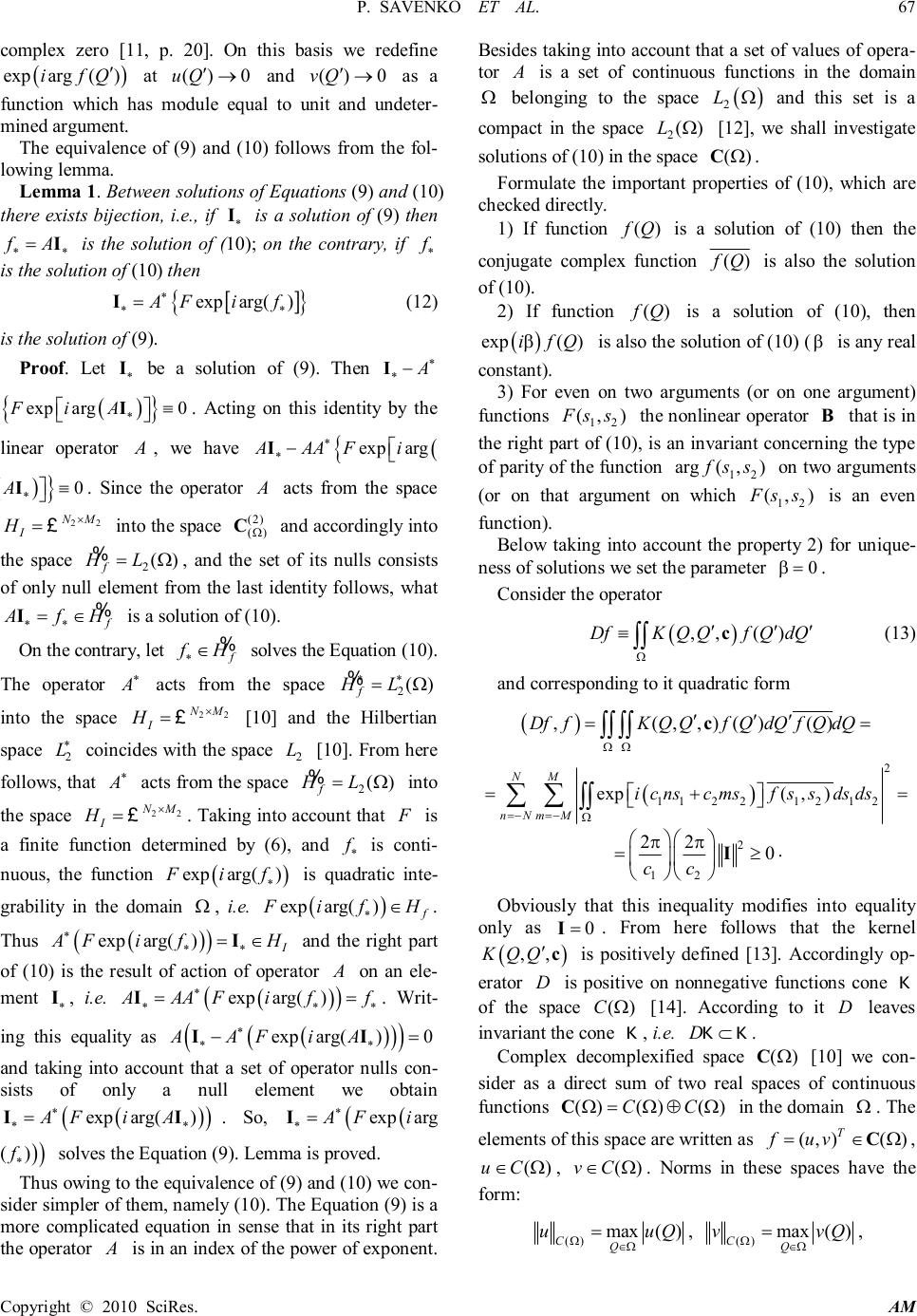 P. SAVENKO ET AL. Copyright © 2010 SciRes. AM 67 complex zero [11, p. 20]. On this basis we redefine ( ) exparg() ifQ ′ at ()0 uQ ′ → and ()0 vQ ′ → as a function which has module equal to unit and undeter- mined argument. The equivalence of (9) and (10) follows from the fol- lowing lemma. Lemma 1. Between solutions of Equations (9) and (10) there exists bijection, i.e., if I ∗ is a solution of (9) then fA I ∗∗ = is the solution of (10); on the contrary, if f ∗ is the solution of (10) then [ ] { } exparg() AFif I ∗ ∗∗ = (12) is the solution of (9). Proof. Let I ∗ be a solution of (9). Then AFiA ∗ ∗∗ −≡ II ( ) { } exparg0 AFiA ∗ ∗∗ −≡ II . Acting on this identity by the linear operator A , we have ( { exparg0 AAAFiA II ∗ ∗∗ −≡ ( ) } exparg0 AAAFiA II ∗∗ −≡ . Since the operator A acts from the space 22 NM I H× = £ into the space (2) () C Ω and accordingly into the space 2 () f HL =Ω % , and the set of its nulls consists of only null element from the last identity follows, what f AfH I∗∗ =∈ % is a solution of (10). On the contrary, let f fH ∗∈ % solves the Equation (10). The operator A ∗ acts from the space 2 () f HL ∗∗ =Ω % into the space 22 NM I H× = £ [10] and the Hilbertian space 2 L ∗ coincides with the space 2 L [10]. From here follows, that A ∗ acts from the space 2 () f HL =Ω % into the space 22 NM I H× = £ . Taking into account that F is a finite function determined by (6), and f ∗ is conti- nuous, the function ( ) exparg() Fif ∗ is quadratic inte- grability in the domain Ω , i.e. ( ) exparg() f FifH ∗∈. Thus ( ) ( ) exparg() I AFifH ∗∗∗ =∈I and the right part of (10) is the result of action of operator A on an ele- ment I ∗ , i.e. ( ) ( ) exparg() AAAFiff I∗ ∗∗∗ == . Writ- ing this equality as ( ) ( ) ( ) exparg()0 AAFiAII ∗ ∗∗ −= and taking into account that a set of operator nulls con- sists of only a null element we obtain ( ) ( ) exparg() AFiAII ∗ ∗∗ =. So, ( ( exparg() AFif I∗ ∗∗ = ) ) exparg()AFif ∗∗ solves the Equation (9). Lemma is proved. Thus owing to the equivalence of (9) and (10) we con- sider simpler of them, namely (10). The Equation (9) is a more complicated equation in sense that in its right part the operator A is in an index of the power of exponent. Besides taking into account that a set of values of opera- tor A is a set of continuous functions in the domain Ω belonging to the space ( ) 2 L Ω and this set is a compact in the space 2 () L Ω [12], we shall investigate solutions of (10) in the space () C Ω . Formulate the important properties of (10), which are checked directly. 1) If function () fQ is a solution of (10) then the conjugate complex function () fQ is also the solution of (10). 2) If function () fQ is a solution of (10), then ( ) exp() ifQ β is also the solution of (10) ( β is any real constant). 3) For even on two arguments (or on one argument) functions 12 (,) Fss the nonlinear operator B that is in the right part of (10), is an invariant concerning the type of parity of the function 12 arg(,) fss on two arguments (or on that argument on which 12 (,) Fss is an even function). Below taking into account the property 2) for unique- ness of solutions we set the parameter 0 β= . Consider the operator ( ) ,,() DfKQQfQdQ c Ω ′′′ ≡∫∫ (13) and corresponding to it quadratic form ( ) ,(,,)()() DffKQQfQdQfQdQ c ΩΩ ′′′ == ∫∫∫∫ ( ) 2 11221212 exp(,) NM nNmM icnscmsfssdsds =−=− Ω =+= ∑∑∫∫ 2 12 22 0 cc ππ =≥ I. Obviously that this inequality modifies into equality only as 0 I = . From here follows that the kernel ( ) ,, KQQ c ′ is positively defined [13]. Accordingly op- erator D is positive on nonnegative functions cone K of the space () C Ω [14]. According to it D leaves invariant the cone K , i.e. D ⊂ KK . Complex decomplexified space () C Ω [10] we con- sider as a direct sum of two real spaces of continuous functions ()()() CCC Ω=Ω⊕Ω in the domain Ω . The elements of this space are written as (,)() T fuv C =∈Ω , () uC ∈Ω , () vC ∈Ω . Norms in these spaces have the form: () max() CQ uuQ Ω∈Ω =, () max() CQ vvQ Ω∈Ω =, 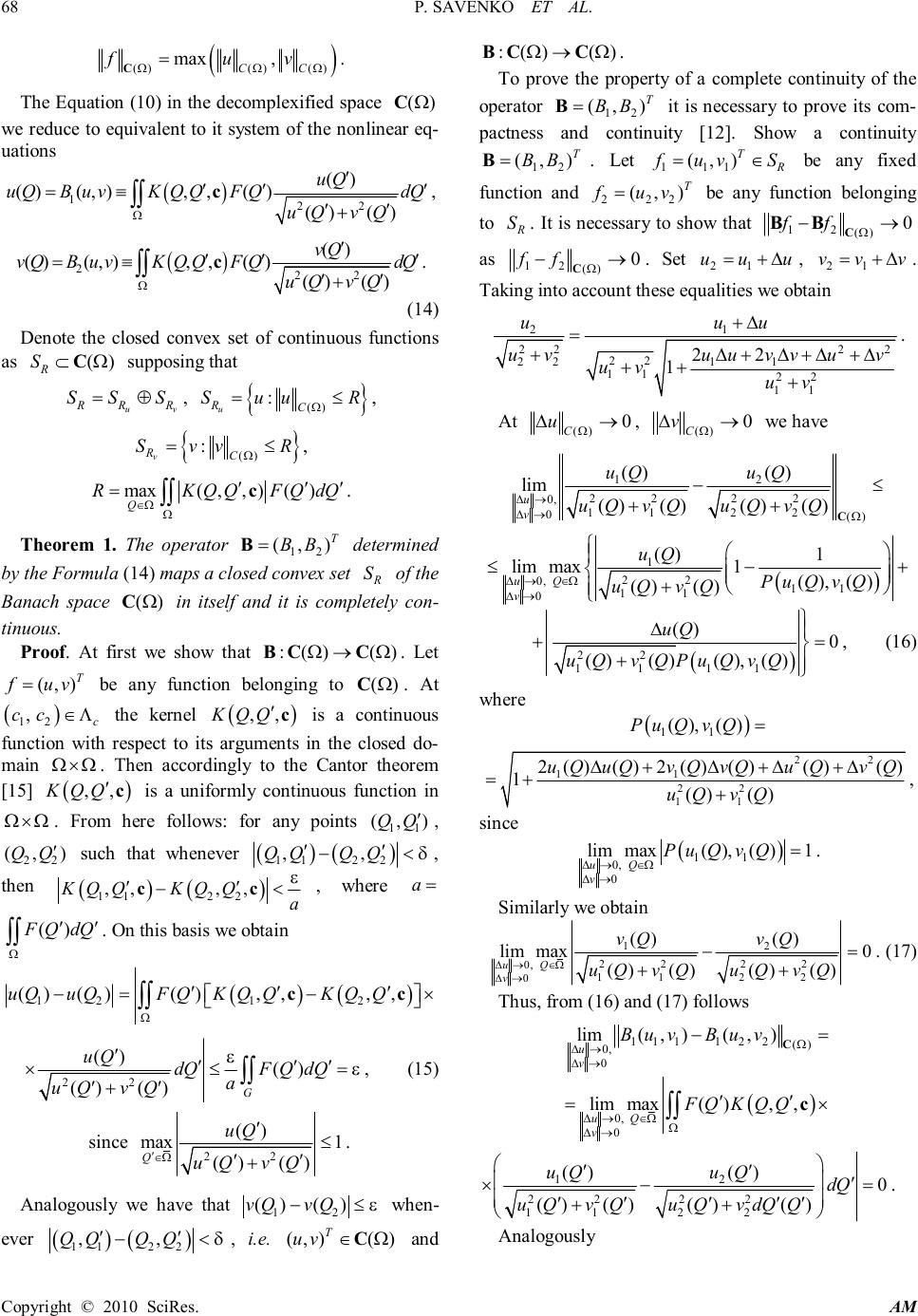 P. SAVENKO ET AL. Copyright © 2010 SciRes. AM 68 ( ) ()()() max, CC fuv CΩΩΩ =. The Equation (10) in the decomplexified space () C Ω we reduce to equivalent to it system of the nonlinear eq- uations ( ) 122 () ()(,),,() ()() uQ uQBuvKQQFQdQ uQvQ c Ω ′ ′′′ =≡ ′′ + ∫∫ , ( ) 222 () ()(,),,() ()() vQ vQBuvKQQFQdQ uQvQ c Ω ′ ′′′ =≡ ′′ + ∫∫ . (14) Denote the closed convex set of continuous functions as () R SC ⊂Ω supposing that uv RRR SSS =⊕, { } () : u RC SuuR Ω =≤, { } () : v RC SvvR Ω =≤, max(,,)() Q RKQQFQdQ c ∈Ω Ω ′′′ =∫∫ . Theorem 1. The operator 12 (,) T BBB= determined by the Formula (14) maps a closed convex set R S of the Banach space () C Ω in itself and it is completely con- tinuous. Proof. At first we show that :()() BCC Ω→Ω . Let (,) T fuv = be any function belonging to () C Ω . At ( ) 12 , c cc ∈Λ the kernel ( ) ,, KQQ c ′ is a continuous function with respect to its arguments in the closed do- main Ω×Ω . Then accordingly to the Cantor theorem [15] ( ) ,, KQQ c ′ is a uniformly continuous function in Ω×Ω . From here follows: for any points 11 (,) QQ ′ , 22 (,) QQ ′ such that whenever ( ) ( ) 1122 ,,QQQQ ′′ −<δ , then ( ) ( ) 1122 ,,,,KQQKQQ a ε ′′ −< cc , where aFQdQ = () aFQdQ Ω ′′ = ∫∫ . On this basis we obtain () () 1212 ()()(),,,,uQuQFQKQQKQQcc Ω ′′′ −=−× ∫∫ 22 () () ()() G uQ dQFQdQ a uQvQ ′ε ′′′ ×≤=ε ′′ +∫∫ , (15) since 22 () max1 ()() Q uQ uQvQ ′ ∈Ω ′ ≤ ′′ +. Analogously we have that 12 ()()vQvQ −≤ε when- ever ( ) ( ) 1122 ,,QQQQ ′′ −<δ , i.e. (,)() T uv C ∈Ω and :()() BCC Ω→Ω . To prove the property of a complete continuity of the operator 12 (,) T BBB= it is necessary to prove its com- pactness and continuity [12]. Show a continuity 12 (,) T BBB=. Let 111 (,) T R fuvS =∈ be any fixed function and 222 (,) T fuv = be any function belonging to R S . It is necessary to show that 12 () 0 ff C BB Ω −→ as 12 () 0 ff CΩ −→ . Set 21 uuu =+∆ , 21 vvv =+∆ . Taking into account these equalities we obtain 21 2222 22 2211 11 22 11 22 1 uuu uvuuvvuv uv uv +∆ = +∆+∆+∆+∆ ++ + . At () 0 C uΩ ∆→ , () 0 C vΩ ∆→ we have 12 2222 0, 1122 0() ()() lim ()()()() u v uQuQ uQvQuQvQC ∆→ ∆→ Ω −≤ ++ () 1 22 0, 11 11 0 () 1 limmax1 (),() ()() u Q v uQ PuQvQ uQvQ ∆→ ∈Ω ∆→ ≤−+ + ( ) 22 1111 () 0 ()()(),() uQ uQvQPuQvQ ∆ += + , (16) where ( ) 11 (),() PuQvQ = 22 11 22 11 2()()2()()()() 1()() uQuQvQvQuQvQ uQvQ ∆+∆+∆+∆ =+ +, since ( ) 11 0, 0 limmax(),()1 uQ v PuQvQ ∆→ ∈Ω ∆→ = . Similarly we obtain 12 2222 0, 1122 0 ()() limmax0 ()()()() uQ v vQvQ uQvQuQvQ ∆→ ∈Ω ∆→ −= ++ . (17) Thus, from (16) and (17) follows 111122 () 0, 0 lim(,)(,) u v BuvBuv Ω ∆→ ∆→ −= C ( ) 0, 0 limmax(),, u Q v FQKQQ ∆→ ∈Ω Ω ∆→ ′′ =× ∫∫ c 12 2222 1122 ()() 0 ()()()() uQuQ dQ uQvQuQvdQQ ′′ ′ ×−= ′′′′′ ++ . Analogously 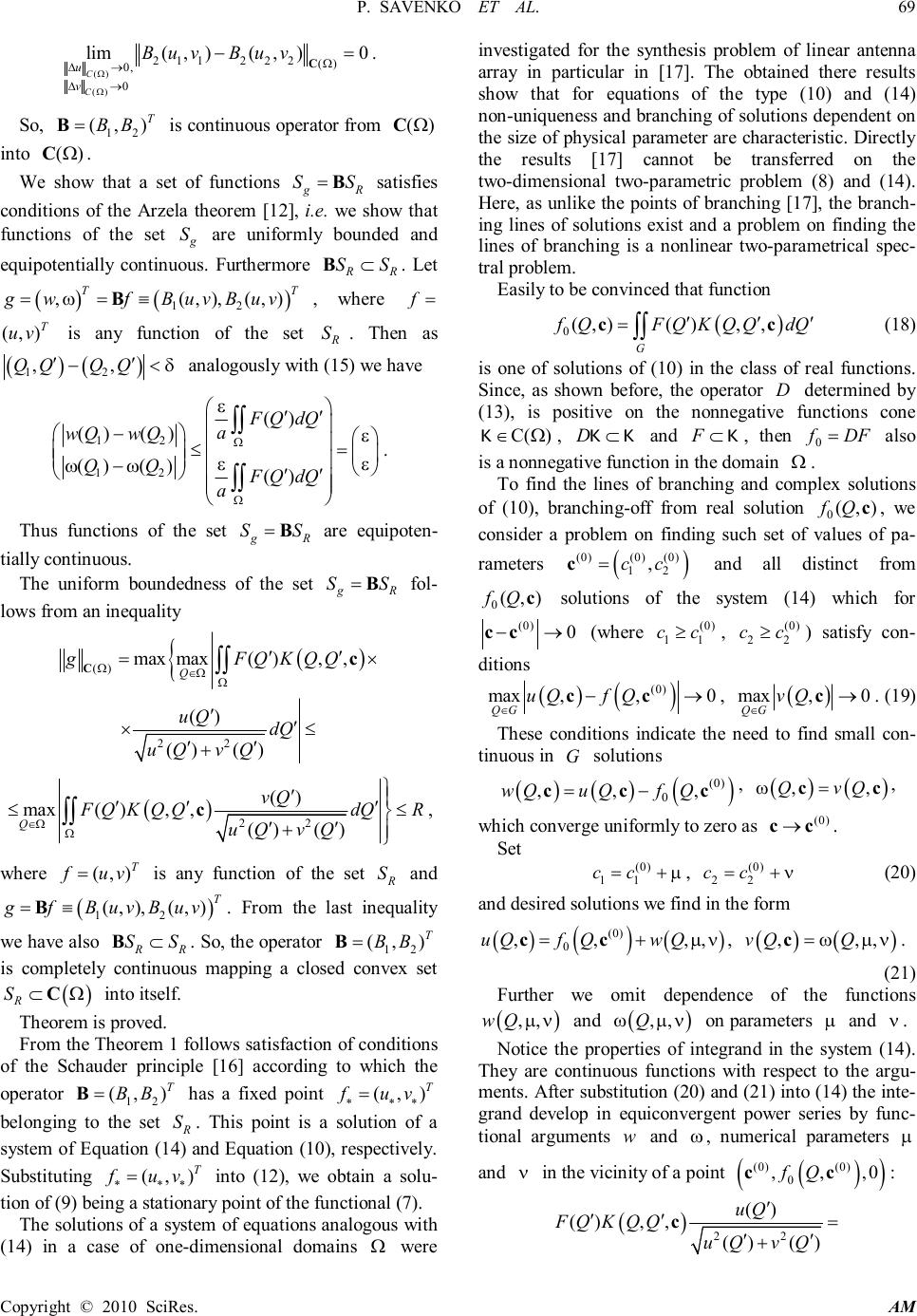 P. SAVENKO ET AL. Copyright © 2010 SciRes. AM 69 () () 211222 () 0, 0 lim(,)(,)0 C C u v BuvBuv C Ω Ω Ω ∆→ ∆→ −= . So, 12 (,) T BBB= is continuous operator from () C Ω into () C Ω . We show that a set of functions gR SS B = satisfies conditions of the Arzela theorem [12], i.e. we show that functions of the set g S are uniformly bounded and equipotentially continuous. Furthermore RR SS B⊂. Let ( )() 12 ,(,),(,) TT gwfBuvBuv =ω=≡B, where fuv = (,) T fuv = is any function of the set R S . Then as ( ) ( ) 12 ,,QQQQ ′′ −<δ analogously with (15) we have 12 12 () ()() ()() () FQdQ a wQwQ QQ FQdQ a Ω Ω ε ′′ − ε ≤= εε ω−ω ′′ ∫∫ ∫∫ . Thus functions of the set gR SS B = are equipoten- tially continuous. The uniform boundedness of the set gR SS B = fol- lows from an inequality { ( ) () maxmax(),, Q gFQKQQ Ω∈Ω Ω ′′ =× ∫∫ C c 22 () ()() uQ dQ uQvQ ′ ′ ×≤ ′′ + ( ) 22 () max(),, ()() Q vQ FQKQQdQR uQvQ c ∈Ω Ω ′ ′′′ ≤≤ ′′ + ∫∫ , where (,) T fuv = is any function of the set R S and ( ) 12 (,),(,) T gfBuvBuv B=≡ . From the last inequality we have also RR SS B⊂. So, the operator 12 (,) T BBB= is completely continuous mapping a closed convex set ( ) R SC ⊂Ω into itself. Theorem is proved. From the Theorem 1 follows satisfaction of conditions of the Schauder principle [16] according to which the operator 12 (,) T BBB= has a fixed point (,) T fuv ∗∗∗ = belonging to the set R S . This point is a solution of a system of Equation (14) and Equation (10), respectively. Substituting (,) T fuv ∗∗∗ = into (12), we obtain a solu- tion of (9) being a stationary point of the functional (7). The solutions of a system of equations analogous with (14) in a case of one-dimensional domains Ω were investigated for the synthesis problem of linear antenna array in particular in [17]. The obtained there results show that for equations of the type (10) and (14) non-uniqueness and branching of solutions dependent on the size of physical parameter are characteristic. Directly the results [17] cannot be transferred on the two-dimensional two-parametric problem (8) and (14). Here, as unlike the points of branching [17], the branch- ing lines of solutions exist and a problem on finding the lines of branching is a nonlinear two-parametrical spec- tral problem. Easily to be convinced that function ( ) 0(,)(),, G fQFQKQQdQ cc ′′′ =∫∫ (18) is one of solutions of (10) in the class of real functions. Since, as shown before, the operator D determined by (13), is positive on the nonnegative functions cone C() ∈Ω K, D ⊂ KK and F ⊂ K , then 0 fDF = also is a nonnegative function in the domain Ω . To find the lines of branching and complex solutions of (10), branching-off from real solution 0 (,) fQ c , we consider a problem on finding such set of values of pa- rameters ( ) (0)(0)(0) 12 ,ccc= and all distinct from 0 (,) fQ c solutions of the system (14) which for (0) 0 cc −→ (where (0) 11 cc ≥, (0) 22 cc ≥) satisfy con- ditions ( ) ( ) (0) max,,0 QGuQfQcc ∈ −→ , ( ) max,0 QG vQc ∈ → . (19) These conditions indicate the need to find small con- tinuous in G solutions ( ) ( ) ( ) (0) 0 ,,,wQuQfQ=−ccc , ( ) ( ) ,, QvQω= cc , which converge uniformly to zero as (0) cc →. Set (0) 11 cc =+µ , (0) 22 cc =+ν (20) and desired solutions we find in the form ( ) ( ) ( ) (0) 0 ,,,, uQfQwQ =+µν cc , ( ) ( ) ,,, vQQ =ωµν c. (21) Further we omit dependence of the functions ( ) ,, wQ µν and ( ) ,, Q ωµν on parameters µ and ν . Notice the properties of integrand in the system (14). They are continuous functions with respect to the argu- ments. After substitution (20) and (21) into (14) the inte- grand develop in equiconvergent power series by func- tional arguments w and ω , numerical parameters µ and ν in the vicinity of a point ( ) ( ) (0)(0) 0 ,,,0 fQcc: ( ) 22 () (),, ()() uQ FQKQQ uQvQ ′ ′′ = ′′ + c 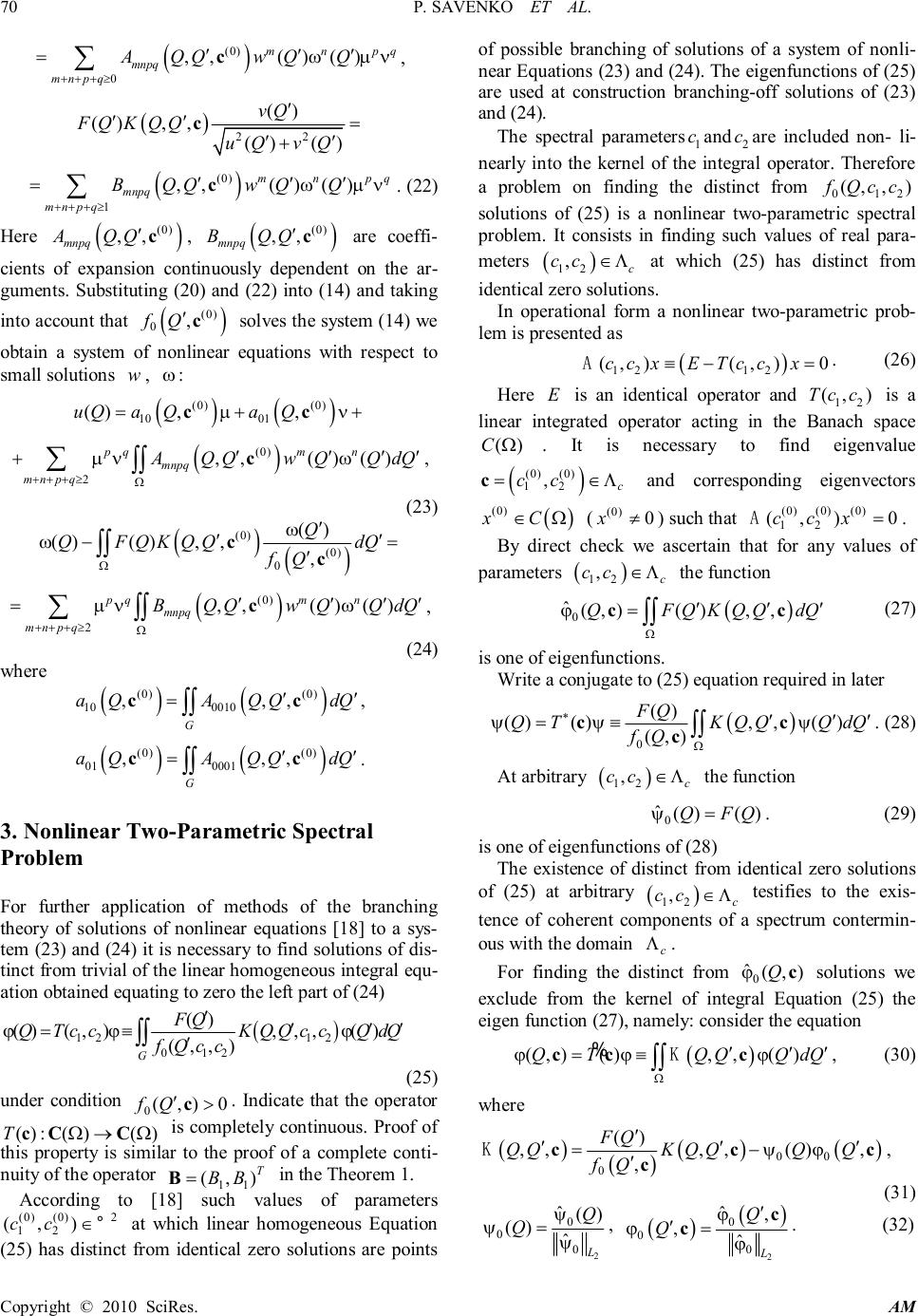 P. SAVENKO ET AL. Copyright © 2010 SciRes. AM 70 ( ) (0) 0 ,,()() mnpq mnpq mnpq AQQwQQ +++≥ ′′′ =ωµν ∑c, ( ) 22 () (),, ()() vQ FQKQQ uQvQ ′ ′′ = ′′ + c ( ) (0) 1 ,,()() mnpq mnpq mnpq BQQwQQ +++≥ ′′′ =ωµν ∑c. (22) Here ( ) (0) ,, mnpq AQQ c ′, ( ) (0) ,, mnpq BQQ c ′ are coeffi- cients of expansion continuously dependent on the ar- guments. Substituting (20) and (22) into (14) and taking into account that ( ) (0) 0,fQ c ′ solves the system (14) we obtain a system of nonlinear equations with respect to small solutions w , ω : ( ) ( ) (0)(0) 1001 (),,uQaQaQ =µ+ν+ cc ( ) (0) 2 ,,()() pqmn mnpq mnpq AQQwQQdQ +++≥ Ω ′′′′ +µνω ∑ ∫∫ c, (23) () ( ) (0) (0) 0 () ()(),, , Q QFQKQQdQ fQ Ω ′ ω ′′ ω−= ′ ∫∫ cc ( ) (0) 2 ,,()() pqmn mnpq mnpq BQQwQQdQ +++≥ Ω ′′′′ =µνω ∑ ∫∫ c, (24) where ( ) ( ) (0)(0) 100010 ,,, G aQAQQdQ cc ′′ =∫∫ , ( ) ( ) (0)(0) 010001 ,,, G aQAQQdQ cc ′′ =∫∫ . 3. Nonlinear Two-Parametric Spectral Problem For further application of methods of the branching theory of solutions of nonlinear equations [18] to a sys- tem (23) and (24) it is necessary to find solutions of dis- tinct from trivial of the linear homogeneous integral equ- ation obtained equating to zero the left part of (24) ( ) 1212 012 () ()(,),,,() (,,) G FQ QTccKQQccQdQ fQcc ′ ′′′ ϕ=ϕ≡ϕ ′ ∫∫ (25) under condition 0 (,)0 fQ c ′ > . Indicate that the operator ():()() T cCC Ω→Ω is completely continuous. Proof of this property is similar to the proof of a complete conti- nuity of the operator 11 (,) T BB B= in the Theorem 1. According to [18] such values of parameters (0)(0)2 12 (,)cc∈ ¡ at which linear homogeneous Equation (25) has distinct from identical zero solutions are points of possible branching of solutions of a system of nonli- near Equations (23) and (24). The eigenfunctions of (25) are used at construction branching-off solutions of (23) and (24). The spectral parameters 1 c and 2 c are included non- li- nearly into the kernel of the integral operator. Therefore a problem on finding the distinct from 012 (,,) fQcc solutions of (25) is a nonlinear two-parametric spectral problem. It consists in finding such values of real para- meters ( ) 12 , c cc ∈Λ at which (25) has distinct from identical zero solutions. In operational form a nonlinear two-parametric prob- lem is presented as ( ) 1212 (,)(,)0 ccxETccx ≡−= A. (26) Here E is an identical operator and 12 (,) Tcc is a linear integrated operator acting in the Banach space () C Ω . It is necessary to find eigenvalue ( ) (0)(0) 12 , c ccc=∈ Λ and corresponding eigenvectors ( ) (0) xC ∈Ω ((0) 0 x ≠ ) such that (0)(0)(0) 12 (,)0 ccx = A. By direct check we ascertain that for any values of parameters ( ) 12 , c cc ∈ Λ the function ( ) 0 ˆ(,)(),, QFQKQQdQ Ω ′′′ ϕ= ∫∫ cc (27) is one of eigenfunctions. Write a conjugate to (25) equation required in later ( ) 0 () ()(),,() (,) FQ QTKQQQdQ fQ ∗ Ω ′′′ ψ=ψ≡ψ ∫∫ cc c. (28) At arbitrary ( ) 12 , c cc ∈ Λ the function 0 ˆ ()() QFQ ψ= . (29) is one of eigenfunctions of (28) The existence of distinct from identical zero solutions of (25) at arbitrary ( ) 12 , c cc ∈ Λ testifies to the exis- tence of coherent components of a spectrum contermin- ous with the domain c Λ . For finding the distinct from 0 ˆ (,) Qϕ c solutions we exclude from the kernel of integral Equation (25) the eigen function (27), namely: consider the equation ( ) (,)(),,() QTQQQdQ ccc Ω ′′′ ϕ=ϕ≡ϕ ∫∫ % K, (30) where () () ()( ) 00 0 () ,,,,(), , FQ QQKQQQQ fQ ccc c ′ ′′′ =−ψϕ ′ K, (31) 2 0 00 ˆ () () ˆ L Q Q ψ ψ= ψ , ( ) ( ) 2 0 00 ˆ , ,ˆL Q Q ′ ϕ ′ ϕ= ϕ c c. (32) 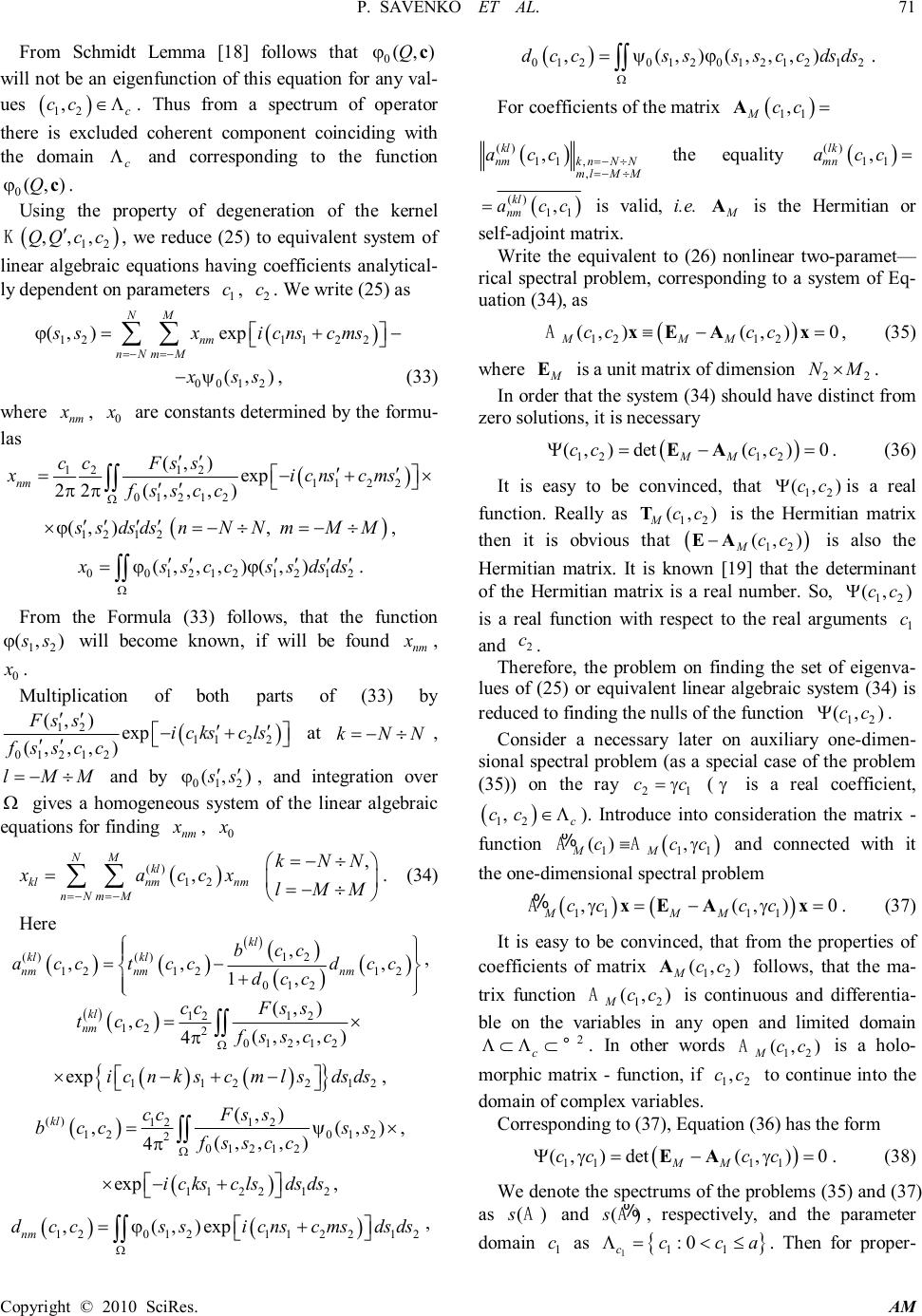 P. SAVENKO ET AL. Copyright © 2010 SciRes. AM 71 From Schmidt Lemma [18] follows that 0 (,) Qϕ c will not be an eigenfunction of this equation for any val- ues ( ) 12 , c cc ∈ Λ . Thus from a spectrum of operator there is excluded coherent component coinciding with the domain c Λ and corresponding to the function 0 (,) Qϕ c . Using the property of degeneration of the kernel ( ) 12 ,,, QQcc ′ K, we reduce (25) to equivalent system of linear algebraic equations having coefficients analytical- ly dependent on parameters 1 c , 2 c . We write (25) as ( ) 121122 (,)exp NM nm nNmM ssxicnscms =−=− ϕ=+− ∑∑ 0012 (,) xss −ψ , (33) where nm x , 0 x are constants determined by the formu- las ( ) 1212 1122 01212 (,) exp 22(,,,) nm ccFss xicnscms fsscc Ω ′′ ′′ =−+× ′′ ππ ∫∫ 1212 (,) ssdsds ′′′′ ×ϕ ( ) , nNNmMM =−÷=−÷ , 0012121212 (,,,)(,) xssccssdsds Ω ′′′′′′ =ϕϕ ∫∫ . From the Formula (33) follows, that the function 12 (,) ss ϕ will become known, if will be found nm x , 0 x . Multiplication of both parts of (33) by ( ) 12 1122 01212 (,) exp (,,,) Fss ickscls fsscc ′′ ′′ −+ ′′ at kNN =−÷ , lMM =−÷ and by 012 (,) ss ′′ ϕ, and integration over Ω gives a homogeneous system of the linear algebraic equations for finding nm x , 0 x ( ) () 12 , NM kl klnmnm nNmM xaccx =−=− =∑∑ , kNN lMM =−÷ =−÷ . (34) Here ( )() ( ) ( ) () ( ) 12 ()() 121212 012 , ,,, 1, kl klkl nmnmnm bcc acctccdcc dcc =− + , ( ) ( ) 1212 12 201212 (,) , (,,,) 4 kl nm ccFss tcc fsscc Ω =× π∫∫ ( )( ) { } 112212 exp icnkscmlsdsds ×−+− , ( ) () 1212 12012 201212 (,) ,(,) (,,,) 4 kl ccFss bccss fsscc Ω =ψ× π∫∫ , ( ) 112212 exp icksclsdsds ×−+ , ( ) ( ) 12012112212 ,(,)exp nm dccssicnscmsdsds Ω =ϕ+ ∫∫ , ( ) 0120120121212 ,(,)(,,,) dccssssccdsds Ω =ψϕ ∫∫ . For coefficients of the matrix ( ) 1111 ,, Mnm ccacc A = ( ) () 1111 ,, ,, kl Mnm knNN mlMM ccacc =−÷ =−÷ = the equality ( ) () 11 , lk mn acc = ( ) () 11 , kl nm acc = is valid, i.e. M A is the Hermitian or self-adjoint matrix. Write the equivalent to (26) nonlinear two-paramet— rical spectral problem, corresponding to a system of Eq- uation (34), as ( ) 1212 (,)(,)0 MMM ccccxEAx ≡−= A, (35) where M E is a unit matrix of dimension 22 NM ×. In order that the system (34) should have distinct from zero solutions, it is necessary ( ) 1212 (,)det(,)0 MM ccccEA Ψ=−= . (36) It is easy to be convinced, that 12 (,) cc Ψ is a real function. Really as 12 (,) M cc T is the Hermitian matrix then it is obvious that ( ) 12 (,) M cc EA − is also the Hermitian matrix. It is known [19] that the determinant of the Hermitian matrix is a real number. So, 12 (,) cc Ψ is a real function with respect to the real arguments 1 c and 2 c . Therefore, the problem on finding the set of eigenva- lues of (25) or equivalent linear algebraic system (34) is reduced to finding the nulls of the function 12 (,) cc Ψ. Consider a necessary later on auxiliary one-dimen- sional spectral problem (as a special case of the problem (35)) on the ray 21 cc =γ ( γ is a real coefficient, ( ) 12 , c cc ∈Λ ). Introduce into consideration the matrix - function ( ) 111 (), MM ccc ≡γ % AA and connected with it the one-dimensional spectral problem ( ) ( ) 1111 ,(,)0 MMM cccc γ=−γ= xEAx % A. (37) It is easy to be convinced, that from the properties of coefficients of matrix 12 (,) M cc A follows, that the ma- trix function 12 (,) M cc A is continuous and differentia- ble on the variables in any open and limited domain 2 c Λ⊂Λ⊂ ¡ . In other words 12 (,) M cc A is a holo- morphic matrix - function, if 12 , cc to continue into the domain of complex variables. Corresponding to (37), Equation (36) has the form ( ) 1111 (,)det(,)0 MM cccc Ψγ=−γ= EA . (38) We denote the spectrums of the problems (35) and (37) as () s A and () s % A , respectively, and the parameter domain 1 c as { } 111 :0 c cca Λ=<≤ . Then for proper- 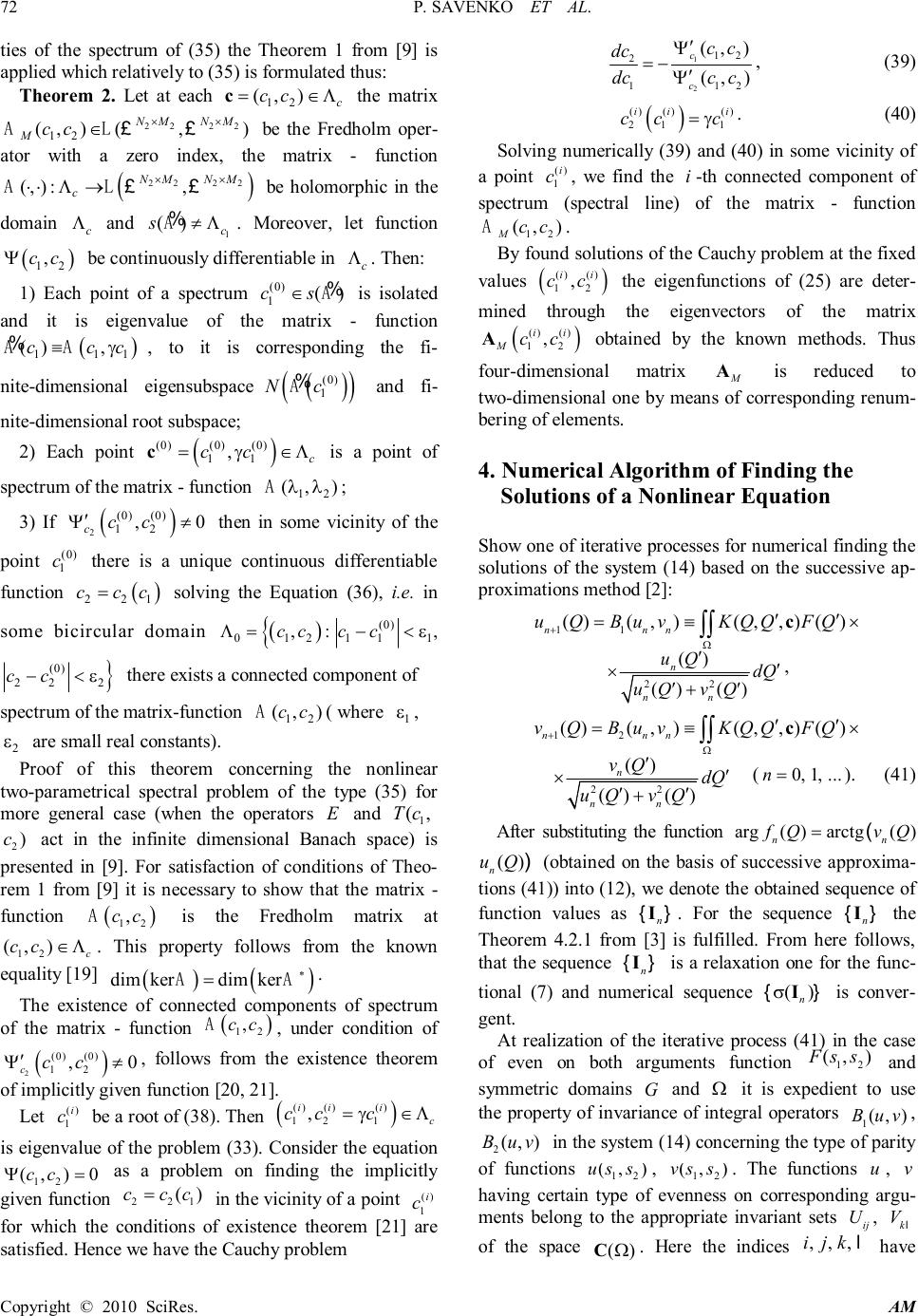 P. SAVENKO ET AL. Copyright © 2010 SciRes. AM 72 ties of the spectrum of (35) the Theorem 1 from [9] is applied which relatively to (35) is formulated thus: Theorem 2. Let at each 12 (,) c ccc =∈Λ the matrix 2222 12 (,)(,) NMNM M cc ×× ∈ ££ AL be the Fredholm oper- ator with a zero index, the matrix - function ( ) 2222 (,):, NMNM c×× ⋅⋅Λ→ ££AL be holomorphic in the domain c Λ and 1 () c s ≠Λ % A. Moreover, let function ( ) 12 , cc Ψ be continuously differentiable in c Λ . Then: 1) Each point of a spectrum (0) 1 () cs∈ % A is isolated and it is eigenvalue of the matrix - function ( ) 111 (), ccc ≡γ % AA , to it is corresponding the fi- nite-dimensional eigensubspace ( ) ( ) (0) 1 Nc % A and fi- nite-dimensional root subspace; 2) Each point ( ) (0)(0)(0) 11 , c cc =γ∈Λ c is a point of spectrum of the matrix - function 12 (,) λλ A; 3) If ( ) 2 (0)(0) 12 ,0 ccc ′ Ψ≠ then in some vicinity of the point (0) 1 c there is a unique continuous differentiable function ( ) 221 ccc = solving the Equation (36), i.e. in some bicircular domain ( ) { (0)(0) 012111222 ,:, cccccc Λ=−<ε−<ε } (0)(0) 012111222 ,:, cccccc Λ=−<ε−<ε there exists a connected component of spectrum of the matrix-function 12 (,) cc A( where 1 ε , 2 ε are small real constants). Proof of this theorem concerning the nonlinear two-parametrical spectral problem of the type (35) for more general case (when the operators E and 1 (, Tc 2 ) c act in the infinite dimensional Banach space) is presented in [9]. For satisfaction of conditions of Theo- rem 1 from [9] it is necessary to show that the matrix - function ( ) 12 , cc A is the Fredholm matrix at 12 (,) c cc ∈Λ . This property follows from the known equality [19] ( ) ( ) dimkerdimker ∗ = AA . The existence of connected components of spectrum of the matrix - function ( ) 12 , cc A, under condition of ( ) 2 (0)(0) 12 ,0 ccc ′ Ψ≠ , follows from the existence theorem of implicitly given function [20, 21]. Let () 1 i c be a root of (38). Then ( ) ()()() 121 , iii c ccc =γ∈Λ is eigenvalue of the problem (33). Consider the equation 12 (,)0 cc Ψ= as a problem on finding the implicitly given function 221 () ccc = in the vicinity of a point () 1 i c for which the conditions of existence theorem [21] are satisfied. Hence we have the Cauchy problem 1 2 12 2 112 (,) (,) c c cc dc dccc ′ Ψ =− ′ Ψ, (39) ( ) ()()() 211 iii ccc =γ . (40) Solving numerically (39) and (40) in some vicinity of a point () 1 i c , we find the i -th connected component of spectrum (spectral line) of the matrix - function 12 (,) M cc A. By found solutions of the Cauchy problem at the fixed values ( ) ()() 12 , ii cc the eigenfunctions of (25) are deter- mined through the eigenvectors of the matrix ( ) ()() 12 , ii M cc A obtained by the known methods. Thus four-dimensional matrix M A is reduced to two-dimensional one by means of corresponding renum- bering of elements. 4. Numerical Algorithm of Finding the Solutions of a Nonlinear Equation Show one of iterative processes for numerical finding the solutions of the system (14) based on the successive ap- proximations method [2]: 11 ()(,)(,,)() nnn uQBuvKQQFQ + Ω ′′ =≡× ∫∫ c 22 () ()() n nn uQ dQ uQvQ ′ ′ ×′′ +, 12 ()(,)(,,)() nnn vQBuvKQQFQ + Ω ′′ =≡× ∫∫ c 22 () ()() n nn vQ dQ uQvQ ′ ′ ×′′ + ( 0,1,... n = ). (41) After substituting the function arg()arctg()() nnn fQvQuQ = () arg()arctg()() nnn fQvQuQ () / (obtained on the basis of successive approxima- tions (41)) into (12), we denote the obtained sequence of function values as n I {} . For the sequence n I {} the Theorem 4.2.1 from [3] is fulfilled. From here follows, that the sequence n I {} is a relaxation one for the func- tional (7) and numerical sequence () n σ I {} is conver- gent. At realization of the iterative process (41) in the case of even on both arguments function 12 (,) Fss and symmetric domains G and Ω it is expedient to use the property of invariance of integral operators 1 (,) Buv , 2 (,) Buv in the system (14) concerning the type of parity of functions 12 (,) uss , 12 (,) vss . The functions u , v having certain type of evenness on corresponding argu- ments belong to the appropriate invariant sets ij U , k V l of the space () Ω C . Here the indices ,,, ijk l have  P. SAVENKO ET AL. Copyright © 2010 SciRes. AM 73 values 0 or 1. In particular, if 1201 (,) ussU ∈ then 1212 (,)(,) ussuss −= and 1212 (,)(,) ussuss −=− . By direct check we are convinced that such inclusions take place: 12 , ijkijijkk BUVUBUVV ⊂⊂ UU ()() lll , ijkijk UVUV ⊂B UU () ll . The possibility of existence of fixed points of the op- erator B belonging to appropriate invariant set (i.e. solutions of system (14) and, respectively, Equation (10)) follows from these relations. 5. Numerical Example Consider an example of approximation of the function ( ) ( ) 1212 (,)cos2sin Fssss =ππ (Figure 1), given in the domain ( ) { } 1212 ,:1,1Gssss =≤≤⊂Ω , for 22 1111 NM ×=× and values of parameters 1 1.6 c= and 2 1.2 c = belonging to the ray 21 0.75 cc =. The possible branching lines of solutions of the system (14) and accordingly the Equation (10), as solutions of two-dimensional spectral problem (25), are shown in Figure 2. Here the first branching lines are denoted by numbers 1 and 2. To the solutions branching-off at the points of these lines there correspond the odd on 2 s functions 12 arg(,) fss and the coefficients of transfor- mation , nm I ( , nNNmMM =−÷=−÷ ) are real, but nonsymmetrical concerning to the plane XOZ . In Figure 3 in logarithmic scale are presented values of the functional σ obtained on the solutions of two types at values of parameter 21 0.75 cc = : the curve 1 Figure 1. The function ()( ) 1212 (,)cos2sin Fssss =ππ given in the domain ( ) { } 1212 ,:1,1Gssss =≤≤⊂Ω . Figure 2. The branching lines of solutions corresponds to solutions in a class of real functions 0 () fQ , curve 2 – to the branching-off solution with odd on 2 s argument ( ) 12 arg, fss . From analysis of Figure 3 follows that at the point 1 0.77 c≈ from real solution branch-off more effective complex-conjugate between themselves solutions, on which the functional σ ac- cepts smaller values, than on the real solution. If to in- troduce into consideration parameter 22 CMc = charac- terizing the quantity of basic functions in transformation (1), the identical efficiency of approximation (identical values of the functional σ on real and branching-off solutions) is reached with use of the branching-off solu- tion at decrease of the quantity of basic functions on the value 21 0.75 Cc ∆=∆ . An amplitude (а) and argument (b) of approximate function are given in Figure 4 for 1 1.6 c= and 2 1.2 c=. The amplitude values of the Fourier Transform coefficients corresponding to this solution are shown in Figure 5. As we see in figure, the values of amplitudes of coefficients are nonsymmetrical concerning the plane Figure 3. The values of functional on initial and branch- ing-off solutions. 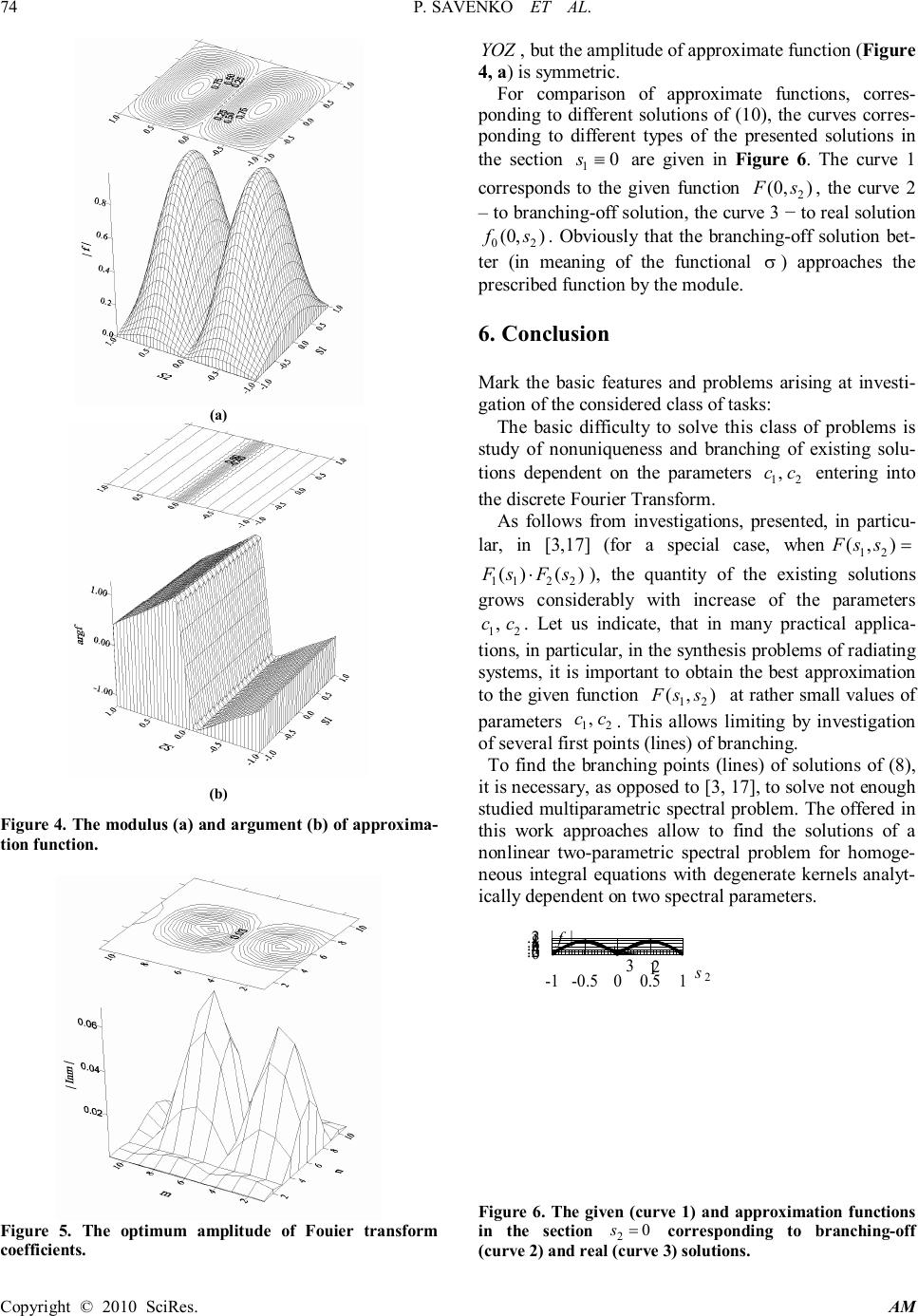 P. SAVENKO ET AL. Copyright © 2010 SciRes. AM 74 (a) (b) Figure 4. The modulus (а) and argument (b) of approxima- tion function. Figure 5. The optimum amplitude of Fouier transform coefficients. YOZ , but the amplitude of approximate function (Figure 4, а) is symmetric. For comparison of approximate functions, corres- ponding to different solutions of (10), the curves corres- ponding to different types of the presented solutions in the section 1 0 s ≡ are given in Figure 6. The curve 1 corresponds to the given function 2 (0,) Fs , the curve 2 – to branching-off solution, the curve 3 − to real solution 02 (0,) fs . Obviously that the branching-off solution bet- ter (in meaning of the functional σ ) approaches the prescribed function by the module. 6. Conclusion Mark the basic features and problems arising at investi- gation of the considered class of tasks: The basic difficulty to solve this class of problems is study of nonuniqueness and branching of existing solu- tions dependent on the parameters 12 , cc entering into the discrete Fourier Transform. As follows from investigations, presented, in particu- lar, in [3,17] (for a special case, when 12 (,) Fss = 1122 ()() FsFs ⋅), the quantity of the existing solutions grows considerably with increase of the parameters 12 , cc . Let us indicate, that in many practical applica- tions, in particular, in the synthesis problems of radiating systems, it is important to obtain the best approximation to the given function 12 (,) Fss at rather small values of parameters 12 , cc . This allows limiting by investigation of several first points (lines) of branching. To find the branching points (lines) of solutions of (8), it is necessary, as opposed to [3, 17], to solve not enough studied multiparametric spectral problem. The offered in this work approaches allow to find the solutions of a nonlinear two-parametric spectral problem for homoge- neous integral equations with degenerate kernels analyt- ically dependent on two spectral parameters. 0 0.2 0.4 0.6 0.8 1 1.2 -1 -0.5 00.5 1 1 2 3 | f | s 2 Figure 6. The given (curve 1) and approximation functions in the section 2 0 s = corresponding to branching-off (curve 2) and real (curve 3) solutions. 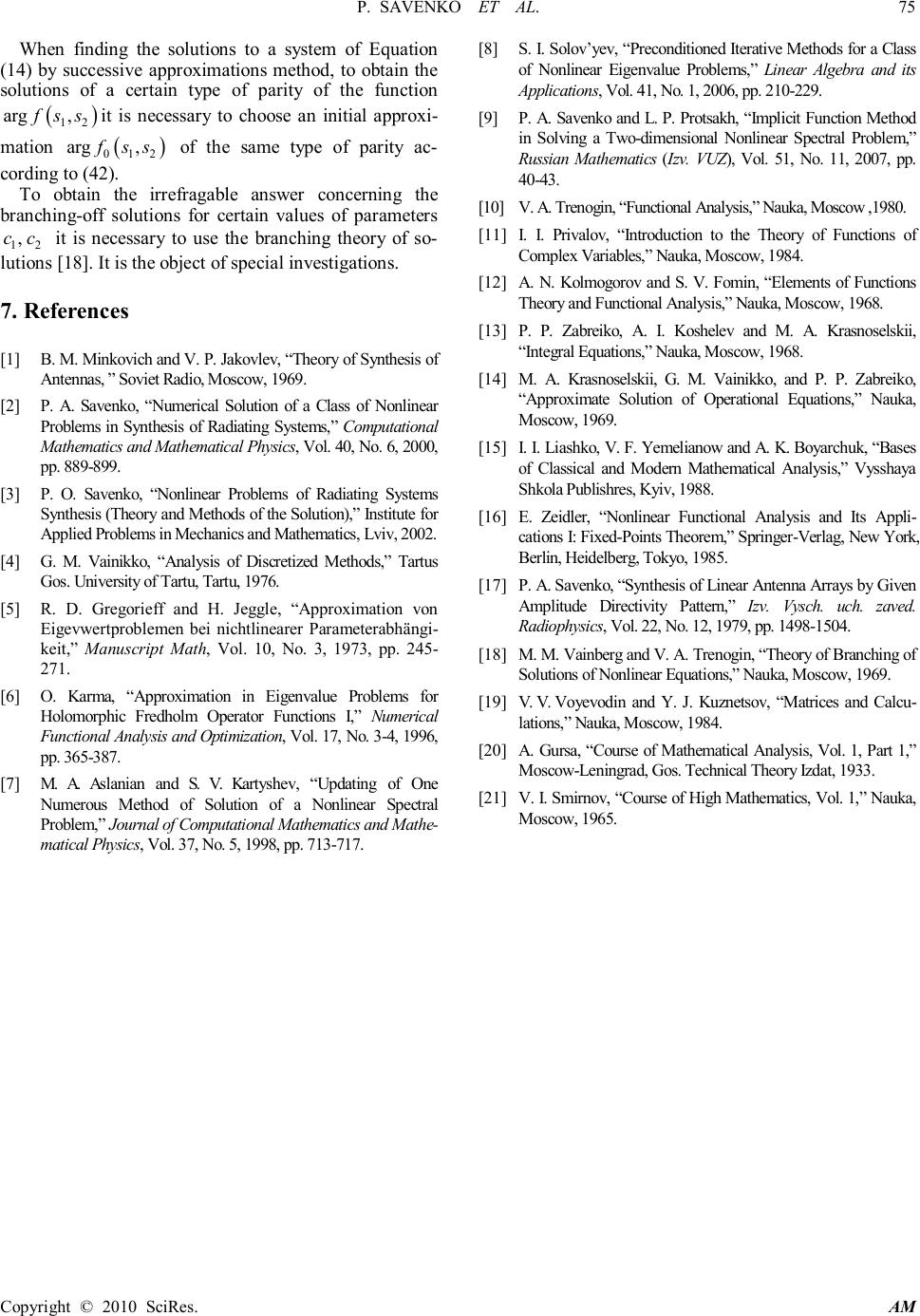 P. SAVENKO ET AL. Copyright © 2010 SciRes. AM 75 When finding the solutions to a system of Equation (14) by successive approximations method, to obtain the solutions of a certain type of parity of the function ( ) 12 arg, fss it is necessary to choose an initial approxi- mation ( ) 012 arg, fss of the same type of parity ac- cording to (42). To obtain the irrefragable answer concerning the branching-off solutions for certain values of parameters 12 , cc it is necessary to use the branching theory of so- lutions [18]. It is the object of special investigations. 7. References [1] B. M. Minkovich and V. P. Jakovlev, “Theory of Synthesis of Antennas, ” Soviet Radio, Moscow, 1969. [2] P. A. Savenko, “Numerical Solution of a Class of Nonlinear Problems in Synthesis of Radiating Systems,” Computational Mathematics and Mathematical Physics, Vol. 40, No. 6, 2000, pp. 889-899. [3] P. O. Savenko, “Nonlinear Problems of Radiating Systems Synthesis (Theory and Methods of the Solution),” Institute for Applied Problems in Mechanics and Mathematics, Lviv, 2002. [4] G. M. Vainikko, “Analysis of Discretized Methods,” Таrtus Gos. University of Tartu, Tartu, 1976. [5] R. D. Gregorieff and H. Jeggle, “Approximation von Eigevwertproblemen bei nichtlinearer Parameterabhängi- keit,” Manuscript Math, Vol. 10, No. 3, 1973, pp. 245- 271. [6] O. Karma, “Approximation in Eigenvalue Problems for Holomorphic Fredholm Operator Functions I, ” Numerical Functional Analysis and Optimization, Vol. 17, No. 3-4, 1996, pp. 365-387. [7] M. A. Aslanian and S. V. Kartyshev, “Updating of One Numerous Method of Solution of a Nonlinear Spectral Problem,” Journal of Computational Mathematics and Mathe- matical Physics, Vol. 37, No. 5, 1998, pp. 713-717. [8] S. I. Solov’yev, “Preconditioned Iterative Methods for a Class of Nonlinear Eigenvalue Problems,” Linear Algebra and its Applications, Vol. 41, No. 1, 2006, pp. 210-229. [9] P. A. Savenko and L. P. Protsakh, “Implicit Function Method in Solving a Two-dimensional Nonlinear Spectral Problem, ” Russian Mathematics (Izv. VUZ ), Vol. 51, No. 11, 2007, pp. 40-43. [10] V. A. Trenogin, “Functional Analysis,” Nauka, Moscow ,1980. [11] I. I. Privalov, “Introduction to the Theory of Functions of Complex Variables,” Nauka, Moscow, 1984. [12] A. N. Kolmogorov and S. V. Fomin, “ Elements of Functions Theory and Functional Analysis,” Nauka, Moscow, 1968. [13] P. P. Zabreiko, А. I. Koshelev and М. А. Krasnoselskii, “Integral Equations,” Nauka, Moscow, 1968. [14] М. А. Krasnoselskii, G. М. Vainikko, and P. P. Zabreiko, “Approximate Solution of Operational Equations,” Nauka, Moscow, 1969. [15] I. I. Liashko, V. F. Yemelianow and A. K. Boyarchuk, “Bases of Classical and Modern Mathematical Analysis,” Vysshaya Shkola Publishres, Kyiv, 1988. [16] E. Zeidler, “Nonlinear Functional Analysis and Its Appli- cations I: Fixed-Points Theorem, ” Springer-Verlag, New York, Berlin, Heidelberg, Tokyo, 1985. [17] P. A. Savenko, “Synthesis of Linear Antenna Arrays by Given Amplitude Directivity Pattern,” Izv. Vysch. uch. zaved. Radiophysics, Vol. 22, No. 12, 1979, pp. 1498-1504. [18] М. M. Vainberg and V. А. Trenogin, “Theory of Branching of Solutions of Nonlinear Equations,” Nauka, Moscow, 1969. [19] V. V. Voyevodin and Y. J. Kuznetsov, “Matrices and Calcu- lations,” Nauka, Moscow, 1984. [20] A. Gursa, “ Course of Mathematical Analysis, Vol. 1, Part 1,” Moscow-Leningrad, Gos. Technical Theory Izdat, 1933. [21] V. I. Smirnov, “Course of High Mathematics, Vol. 1,” Nauka, Moscow, 1965. |

